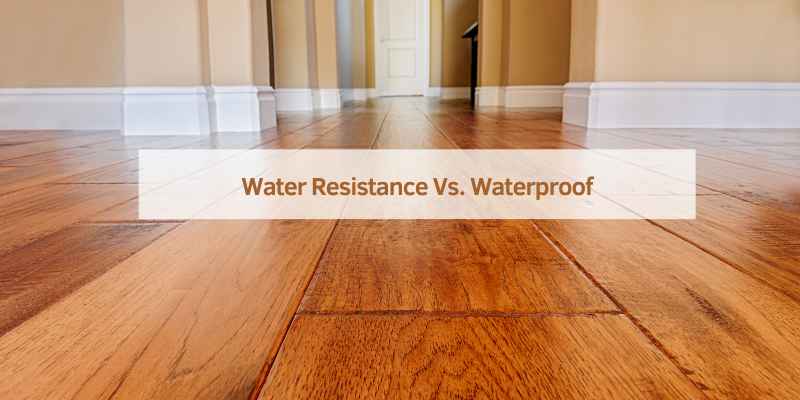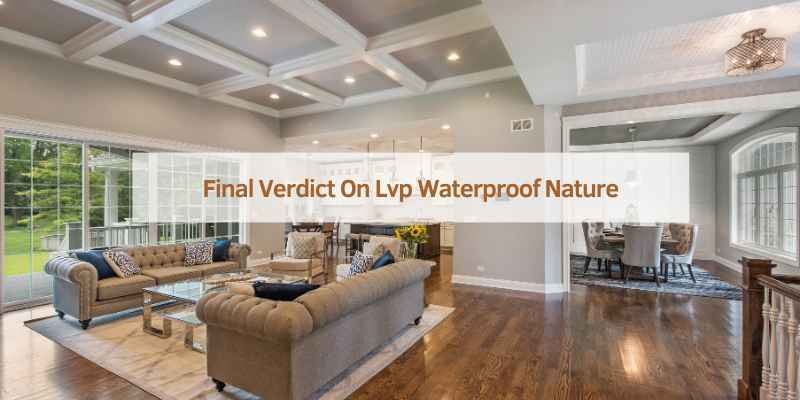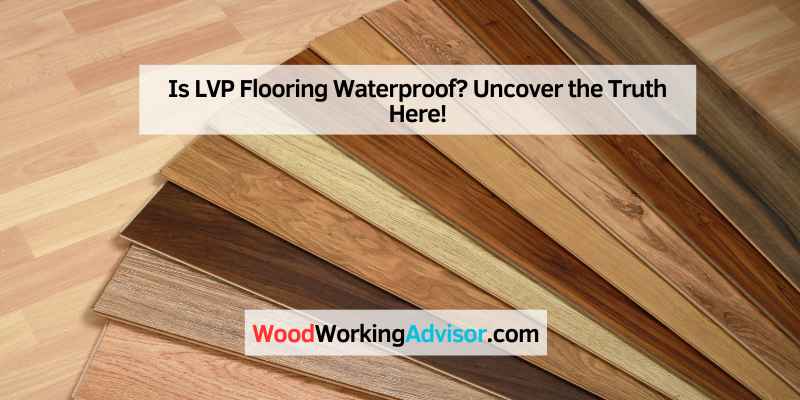Yes, LVP flooring is waterproof. It resists water damage, making it ideal for moisture-prone areas.
Luxury Vinyl Plank (LVP) flooring offers a durable and stylish solution for any home. Its waterproof nature makes it perfect for kitchens, bathrooms, and basements. LVP mimics the appearance of hardwood, providing a high-end look without the hassle. The easy installation process and low maintenance needs add to its appeal.
With LVP flooring, you enjoy the beauty of wood with the practicality of vinyl. This flooring option also stands up well to heavy foot traffic and pets. Its affordability and versatility make it a popular choice among homeowners. Whether you’re renovating or building new, LVP flooring is a smart investment.
Introduction To Lvp Flooring
Luxury Vinyl Plank (LVP) flooring has become a popular choice in modern homes. It offers durability, aesthetics, and ease of maintenance. Many homeowners are now choosing LVP for its affordability and stylish looks. But is LVP flooring waterproof? Let’s dive into the details.
The Rise Of Luxury Vinyl Plank
LVP flooring has seen a significant rise in popularity. This rise is due to its versatility and affordability. LVP mimics the look of hardwood floors. It offers a more cost-effective option without sacrificing style.
LVP is also known for its durability. It can withstand heavy foot traffic and everyday wear and tear. This makes it an excellent choice for busy households.
Another reason for its popularity is its ease of installation. Many DIY enthusiasts find LVP flooring easy to install. It often features a click-lock system, which simplifies the process.
Components Of Lvp
LVP flooring is made up of several layers. Each layer has a unique purpose and contributes to the flooring’s overall performance.
| Layer | Description |
|---|---|
| Wear Layer | This top layer provides protection against scratches and stains. It ensures the flooring looks good for years. |
| Design Layer | This layer features the printed design. It mimics the appearance of wood, stone, or tile. |
| Core Layer | This layer offers stability and durability. It is often made of PVC, providing waterproof properties. |
| Backing Layer | This bottom layer provides additional support and stability. It helps to ensure the flooring stays in place. |
The combination of these layers creates a flooring option that is both stylish and practical. LVP flooring is designed to handle the demands of everyday life, making it a great choice for many homeowners.
Water Resistance Vs. Waterproof
Understanding the difference between water resistance and waterproof is crucial for choosing the right flooring. These terms often confuse buyers. Knowing the distinction helps in making informed decisions.
Defining The Terms
Water-resistant flooring can handle small spills and humidity. It won’t get damaged easily by water. But, it is not completely immune to water. Waterproof flooring offers complete protection against water. It doesn’t absorb water at all.
Comparing Flooring Options
Let’s compare different types of flooring in terms of water resistance and waterproofing:
| Flooring Type | Water Resistance | Waterproof |
|---|---|---|
| Laminate | Yes | No |
| Vinyl Plank (LVP) | Yes | Yes |
| Hardwood | No | No |
| Ceramic Tile | Yes | Yes |
Laminate flooring is water-resistant but not waterproof. It can handle minor spills but will get damaged with prolonged exposure. Hardwood flooring is neither water-resistant nor waterproof. It swells and warps when exposed to water.
LVP flooring is both water-resistant and waterproof. This makes it a popular choice for kitchens and bathrooms. Ceramic tiles are also waterproof and resistant to water damage.
Choosing the right flooring depends on where you plan to install it. For areas prone to spills or moisture, waterproof options like LVP or ceramic tiles are best.
- Water-resistant flooring can handle small spills.
- Waterproof flooring offers complete water protection.
- LVP flooring is both water-resistant and waterproof.

The Anatomy Of Lvp
Luxury Vinyl Plank (LVP) flooring is popular for its durability and waterproof properties. Understanding its structure helps grasp why it is a top choice for many homeowners. LVP is crafted through multiple layers, each contributing to its strength and water resistance.
Layers That Make A Difference
LVP flooring is made up of several layers. Each layer plays a crucial role in its performance.
- Wear Layer: This top layer protects against scratches and stains. It ensures the flooring remains beautiful for years.
- Printed Vinyl Layer: This layer gives the floor its look. It can mimic wood, stone, or other materials.
- Core Layer: The core layer provides stability and waterproof properties. It is the backbone of the LVP flooring.
- Backing Layer: This bottom layer adds extra support and prevents moisture from seeping in.
Core Materials Explored
The core of LVP is vital for its waterproof feature. It is made from different materials.
| Material | Properties |
|---|---|
| WPC (Wood Plastic Composite) | Combines wood and plastic. It is durable and waterproof. |
| SPC (Stone Plastic Composite) | Mixes stone and plastic. It offers even greater durability and water resistance. |
WPC cores are softer, providing a comfortable feel underfoot. They are perfect for residential areas.
SPC cores are denser and more rigid. They are ideal for high-traffic areas and commercial spaces.
Choosing the right core material depends on your needs. Both WPC and SPC offer excellent waterproof qualities, ensuring your floors stay beautiful and dry.
Testing Lvp’s Water Resistance
Luxury Vinyl Plank (LVP) flooring is popular for its durability and aesthetic appeal. One key feature is its water resistance. But how waterproof is it? Let’s explore the various methods used to test LVP’s water resistance and what the results reveal.
Common Testing Methods
Testing LVP’s water resistance involves several methods. These tests ensure the flooring can handle spills and moisture.
- Submersion Test: LVP samples are submerged in water for a specified period. This test checks for swelling or damage.
- Surface Spill Test: Water is poured on the LVP surface. Observers check how long it takes for the water to penetrate or damage the surface.
- Humidity Test: LVP is placed in a high-humidity chamber. The flooring is observed for any warping or mold growth.
What The Results Show
The results from these tests are promising. LVP flooring generally shows high resistance to water.
| Test Type | Results |
|---|---|
| Submersion Test | LVP shows minimal swelling and no structural damage. |
| Surface Spill Test | Water sits on the surface for hours without penetration. |
| Humidity Test | No warping or mold growth is observed in high humidity. |
Submersion tests reveal that LVP maintains its integrity even when submerged for an extended time. The surface spill test shows that LVP can handle spills without immediate damage. In high humidity environments, LVP remains stable and free from mold, making it a great option for moisture-prone areas.
Real-life Scenarios
Luxury Vinyl Plank (LVP) flooring is popular. But is it truly waterproof? Let’s explore real-life scenarios. Understand how LVP flooring handles everyday spills and long-term exposure.
Everyday Spills And Accidents
Everyday spills happen in every home. Think of spilled juice, water, or even pet accidents. LVP flooring can handle these. It is designed to resist water. Wipe up spills quickly, and your floor stays safe.
Accidents are common in kitchens and bathrooms. LVP flooring shines in these areas. Its waterproof nature protects it from damage. You can cook, bathe, and play without worry.
Long-term Exposure Effects
Long-term water exposure can be a concern. What if there is a leak or flood? LVP flooring holds up well in these cases. It is built to resist water damage.
Let’s look at the effects of standing water on LVP flooring:
| Time | Effect |
|---|---|
| 1 hour | No damage |
| 6 hours | Minor swelling, easy to fix |
| 24 hours | Possible edge lifting, needs attention |
Proper maintenance is key. Use mats and rugs in wet areas. Regular checks for leaks can save you trouble.
Installation Considerations
Understanding the installation considerations for LVP flooring is crucial. Proper installation ensures your floor remains waterproof and durable. This section covers key points to keep in mind.
Proper Sealing Techniques
Proper sealing techniques are vital for LVP flooring. Sealing the seams correctly prevents water from seeping through. Use a high-quality sealant designed for LVP floors.
Follow these steps for effective sealing:
- Clean the seams thoroughly.
- Apply the sealant evenly along each seam.
- Allow the sealant to dry completely.
Regularly inspect the seals to ensure they remain intact. Proper maintenance extends the life of your LVP flooring.
Professional Vs. Diy
Deciding between professional installation and DIY is important. Professional installers have the experience and tools required.
Here is a comparison table to help you decide:
| Professional Installation | DIY Installation |
|---|---|
| Guaranteed quality | Cost-effective |
| Faster completion | Requires time and effort |
| Access to specialized tools | May need to buy or rent tools |
Professional installation ensures a flawless finish. DIY can be rewarding but challenging. Consider your skills and time before deciding.
Maintenance And Care
Maintaining your LVP flooring is easy and straightforward. Proper care ensures it remains beautiful and durable. Here are some tips for keeping your floors in top shape.
Cleaning Do’s And Don’ts
- Do sweep or vacuum regularly to remove dirt and debris.
- Do use a damp mop for routine cleaning.
- Don’t use abrasive cleaners or scrubbers.
- Don’t soak the floor with water.
Preventing Water Damage
Even though LVP flooring is waterproof, preventing water damage is important. Here are some tips:
- Place mats at entrances to trap moisture.
- Wipe up spills immediately to avoid standing water.
- Use protective pads under furniture to prevent scratches.
Regular maintenance keeps your LVP flooring looking new. Follow these simple steps to enjoy its beauty and durability for years.
Case Studies
Case studies help us understand the real-world performance of LVP flooring. Let’s explore how it performs in both residential and commercial settings.
Residential Examples
Many homeowners choose LVP flooring for its durability. One family installed LVP in their kitchen. They reported no water damage even after accidental spills. Another homeowner used LVP in their bathroom. They found it easy to clean and maintain. The waterproof quality of LVP flooring kept their bathroom looking new.
Here is a comparison of different residential uses of LVP flooring:
| Area | Experience |
|---|---|
| Kitchen | No water damage from spills |
| Bathroom | Easy to clean and maintain |
| Basement | Resistant to moisture |
Commercial Settings Insights
Businesses also benefit from LVP flooring. A restaurant owner installed LVP flooring in the dining area. It withstood high foot traffic without wear. Another case involved an office space. They chose LVP for its easy maintenance. The waterproof nature kept the floors looking professional. A retail store found LVP flooring ideal for its showroom. They appreciated the quick clean-up of spills.
Key points from commercial settings:
- Restaurants: Withstands high traffic
- Offices: Easy maintenance and professional look
- Retail stores: Quick clean-up of spills
Making The Right Choice
Choosing the right flooring is crucial for any home or office. One popular choice is Luxury Vinyl Plank (LVP) flooring. But is LVP flooring truly waterproof? Let’s explore this topic to help you make an informed decision.
Assessing Your Needs
Before deciding on LVP flooring, assess your specific needs. Do you need flooring for a high-moisture area? If yes, LVP flooring could be an ideal choice. LVP is known for its water-resistant properties. This makes it suitable for kitchens, bathrooms, and basements.
Consider your lifestyle. If you have kids or pets, spills are inevitable. LVP flooring can handle these spills without damage. Think about maintenance. LVP requires minimal upkeep, which is perfect for busy households.
Lvp Alternatives
While LVP flooring offers many benefits, it’s important to consider alternatives. Ceramic tiles are another waterproof option. They are durable and come in various designs. Engineered hardwood provides a natural wood look but with better moisture resistance than traditional hardwood.
Laminate flooring is another alternative. It is not as water-resistant as LVP but is often more affordable. Here’s a quick comparison table:
| Flooring Type | Water Resistance | Durability | Cost |
|---|---|---|---|
| LVP Flooring | High | High | Moderate |
| Ceramic Tiles | High | High | High |
| Engineered Hardwood | Moderate | High | High |
| Laminate Flooring | Low | Moderate | Low |
Evaluate all options to find the best flooring for your needs. Each type has its pros and cons, so choose wisely.
Final Verdict On Lvp Waterproof Nature
Luxury Vinyl Plank (LVP) flooring has become a popular choice for many homes. One major reason is its water-resistant properties. But is LVP flooring truly waterproof? Let’s dive into the details.
Summarizing The Evidence
LVP flooring is made from multiple layers. These layers include a protective wear layer, a printed design layer, and a core layer. The core layer is often made of PVC, which is water-resistant.
Water-resistance means LVP can handle spills and moisture without damage. True waterproofing means the material can be submerged in water without degrading. LVP flooring falls more into the water-resistant category. It can withstand everyday spills, but prolonged exposure to water might cause issues.
Many homeowners report positive experiences with LVP in kitchens and bathrooms. These areas often face moisture, and LVP holds up well. However, it’s crucial to address spills quickly to maintain the flooring’s integrity.
Recommendations For Consumers
If you’re considering LVP flooring for your home, here are some tips:
- Use LVP in areas prone to moisture like kitchens and bathrooms.
- Quickly clean up spills to avoid potential damage.
- Consider placing mats in entryways to reduce water exposure.
- For areas with high water risk, look into waterproof alternatives.
Remember, while LVP is highly water-resistant, it is not completely waterproof. Proper care can extend its life and maintain its appearance.

Frequently Asked Questions
Is Lvp Flooring 100% Waterproof?
Yes, LVP flooring is 100% waterproof. It resists moisture, making it ideal for kitchens and bathrooms.
What Happens If Lvp Gets Wet?
LVP (Luxury Vinyl Plank) is water-resistant but not waterproof. Prolonged exposure to water can cause damage. Dry it quickly to prevent warping or mold.
What Is The Downside Of Lvp Flooring?
LVP flooring can be prone to scratches. It may not increase home value. Subfloor imperfections can telegraph through.
Is Lvp More Waterproof Than Laminate?
Yes, LVP is more waterproof than laminate. LVP is made from vinyl, which is naturally water-resistant. Laminate has a core that can swell with moisture. LVP is better for wet areas like bathrooms and kitchens.
Conclusion
LVP flooring is a top choice for waterproof flooring. Its durability and water resistance make it ideal. Whether in kitchens, bathrooms, or basements, LVP provides peace of mind. Enjoy a stylish, low-maintenance floor with LVP. Make the smart choice for your home and invest in waterproof LVP flooring today.

